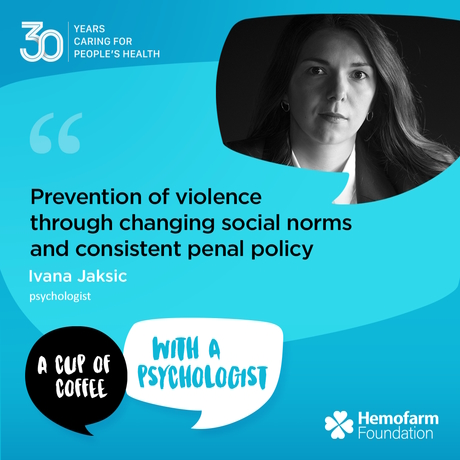
25/05/2023
Fighting against Violence – Tasks for Society
Ivana Jakšić
Psychologist
Fighting against Violence – Tasks for Society
The tragedies in Vladislav Ribinkar Primary School and in Mladenovac have created a radical cut in our perception of social reality. Serbia has stopped, pondering over the problem of violence in the society, its causes, and efficient ways to prevent it. Tragedies tend to alter perception of passage of time. Due to the intensive direction of attention, the time after a tragedy seems to go by slower, while the events that preceded it seem more distant in the past than they really are. It is therefore worth recalling that the nation had been shaken by disturbing reports of violence on the eve of the tragedy as well. Reports on peer violence were flooding from schools, as well as those on violence directed at teachers. The political arena is marked with an atmosphere of intimidation and labelling of people of different views, while civilian activism is often condemned with hate speech. The media are full of images of violence and unethical reports on violence. An eight-year-old girl was saved from her abusive father at the last moment, while elsewhere girls and women are falling victims of male violence on a weekly basis.
What changed on 3rd of May? We were aware that we were living surrounded by violence well before that day with – as surveys consistently demonstrated, little trust in institutions to protect us. Nevertheless, we believed in our own capacities to prevent negative events, believing that they were happening to someone else. Asked in one survey conducted by the Institute of Pedagogical Research on what quality they would like their children to develop in the future, the parents of pupils in senior primary school grades unanimously responded – resourcefulness. We believed we would be resourceful and able to protect ourselves and our beloved ones. If we teach our child to fight back, if we take his/her telephone away from him/her, if we chose our partner wisely, if we do not get involved in politics… This tragedy shook the foundations of such beliefs. Just like the parents of the children from Vladislav Ribnikar Primary School, we could have done everything well, and still we would not have been able to protect our own ‘little fortresses’ and what’s most precious in them – our children.
It is very hard to face the realisation that the control we have over events is limited or completely missing. As we are growing up we learn to assess how much control we have and how to cope with the feeling of helplessness which accompanies absence of control. In order to retrieve the feeling of control and protect ourselves in the future, we frantically try to untangle the densely intertwined webs of the causes of tragic events. It is opportune to turn to scientific knowledge. Science is an achievement of civilisation developed in order to let us control events in the future with more success through understanding causes. Alas, as opposed to laws of physics, laws of human behaviour cannot be applied to individuals. The best the behavioural sciences can offer is to spot similarities in a large number of cases and candidate them as possible causes. For example, less than a fifth of perpetrators of school shootings played violent video games. This piece of information is sufficient to go search for causes elsewhere. Besides, taking into account that school shootings are luckily rare events, science has very limited samples of cases for an analysis of potential causes. A careful investigation and psychological questioning of perpetrators offer valuable information on potential motivation, yet the conclusions in individual cases always remain at the level of more or less substantiated assumptions.
Although science cannot give us a precise answer on why 3rd May happened, its conclusions are the only thing we can rely on when formulating preventive actions. Research of violence and its various forms reveal that it is a socially determined problem. Aggressiveness is an inborn feature, yet – how, towards whom, and in what situations it is going to be manifested, is learnt through socialisation, just like any other rule of social behaviour. We cannot apply any form of violent behaviour unless we have previously seen it. In societies in which we are often exposed to such behaviours, our tolerance for violence is growing, and our emotional response is getting weaker. We first learn of violence in our family, then at school and in peer groups, as well as continuously through media, culture, and public speech. In this sense, prevention of violence must be directed at changing social norms through changing all the mentioned socialisation agents. Norms are socialised through penal policies, too, and studies have shown that the severity of punishment is not so vital for reducing violence (death penalty does not reduce the number of criminal offences) as the speed, certainty and consistency in punishment.
Social norms create fertile soil for manifestation of violence. Still, it is clear that individuals within a same society differ greatly in their violent behaviour. Studies of violent behaviour among young people indicate the importance of the combination of genetic and personal predispositions and environmental circumstances. These include low degree of self-control, violence suffered at childhood age, social rejection by peers, or belonging to peer groups that approve of violent behaviour. Research studies conducted on a small sample of perpetrators of school shootings are before all indicative of vulnerable personal constitution, shaped by an inadequate family environment at the early age, and later by problems in social functioning in a peer group, that is, motivation to transform the feeling of shame, humiliation and rejection into a feeling of pride. Social exclusion is at the same time the strongest predictor of suicide in young people. In this key we can also interpret the findings of studies that do not find positive effects of safety policies such as increasing numbers of school police officers and introduction of metal detectors. Not only do these measures fail in dealing with the causes, but they also have negative effects on mental health of pupils/students, creating feelings of fear and anxiety. In addition, such measures are also accompanied with an increase in peer violence, probably because they signalise to the students that the world is not a safe place, and that other people are dangerous. A more purposeful approach would be to offer support to the mental health of young people, improving their emotional literacy, and empowering all the factors in resolving problems of peer violence (pupils, students, parents, teachers, and school associates).
Now when it is standing still, Serbia must realise that we cannot resolve the problem of violence among young people through individual resourcefulness. Although each individual can contribute to this goal through modelling a non-violent behaviour, pointing out to violence, offering support to victims and prevention go beyond individual efforts. What we need is thinking over, a strategic approach, collaboration of all the factors in the society, and hard work for the future. The responsibility for such changes lies on the entire society, but it is not equally distributed. Although a number of initiatives by various associations (students’, parents’, professional – teachers’ and psychologists’) have surfaced after the tragedy, for resolving the problem of violence in the society a powerful political will must exist which would mobilise multidisciplinary teams of experts and provide them necessary resources. Such a broad social action would be primarily directed towards strengthening social and emotional competences in children (through all teaching subjects and extracurricular programmes), through improvement of parents’ and teachers’ educational competences (through parenting support programmes and through innovation of initial education of teachers), and also towards a change of the widespread social norms of violent behaviour (through stricter regulation of media and promotion of prosocial content).
The recent tragedies have painfully demonstrated that we cannot protect ourselves from violence by empowering only ourselves and our closest environment, by fortifying our own ‘little fortresses’. Only through solidarity, cooperation and strengthening the foundations of each of them, we can build a powerful fortification for fighting violence in the society.

AUTHOR
Ivana Jakšić
Psychologist